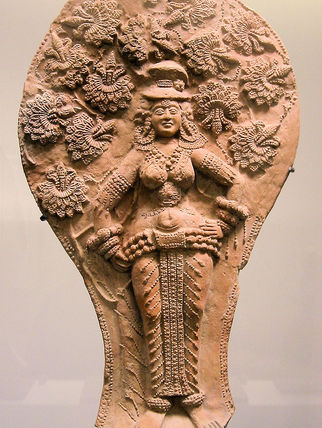
Yakshinis
Yakshinis are minor female deities in Hinduism, Buddhism, and Jainism. Yakshinis are the female counterpart of Yakshas and are considered nature spirits and worshipped as guardian deities. Yakshinis are a typical representation of feminine beauty and fertility in Indian architecture. Yakshinis are frequently shown as beautiful young females standing beside a tree, holding the branch of a stylized flowering tree, or holding garlands. They are often found carved on the railing, casings, and gateways in Buddhist and Hindu temples. In Hinduism and Buddhism, they are considered as the attendants of Kubera, while in Jainism, a class of Devis called Yakshinis, are regarded as the attendants of Jinas.
Salabhanjika
The name "Salabhanjika" refers to any statue found on pillars, walls, or halls. However, it is also connected with feminine characters standing beside or clutching a sal tree, which is frequently misidentified as an Ashoka tree. The Ashoka tree is strongly related to yakshinis, and the girl emblem at the tree's base is an ancient theme representing fertility and seduction. These Shalabhanjika figurines are frequently utilized as decorative components in the interior and exterior architecture of Buddhist, Hindu, and Jain religious institutions.
Didarganj Yakshini
Didarganj Yakshini is a prominent sculpture from the Mauryan period, approximately the third century BCE. The beautiful posture, exquisite jewelry, and carefully crafted attire of this sandstone statue of a female figure, or Yakshini, symbolize ideals of feminine beauty and fertility.
Yakshinis in Uddamareshvara Tantra
The Uddamareshvara Tantra and the Tantraraja Tantra give information on thirty-six Yakshinis, as well as the mantras and rituals associated with them. These mysterious beings are known for bestowing wishes and protecting secret treasures within the earth. Yakshinis have a variety of characters, displaying both kindness and fierceness. Following are the thirty six Yakshinis mentioned in the Uddamareshvara Tantra:
1. Vichitra
2. Vibhrama
3. Hamsi
4. Bhishani
5. Janaranjika
6. Vishala
7. Madana
8. Ghanta
9. Kalakarni
10. Mahabhaya
11. Mahendri
12. Shankhini
13. Chandri
14. Shmashana
15. Vatayakshini
16. Mekhala
17. Vikala
18. Lakshmi
19. Malini
20. Shatapatrika
21. Sulochana
22. Shobha
23. Kapalini
24. Varayakshini
25. Nati
26. Kameshvari
27. Apsara
28. Karnapisachi
29. Manohara
30. Pramoda
31. Anuragini
32. Nakhakeshi
33. Bhamini
34. Padmini
35. Svarnavati
36. Ratipriya
Yakshinis in folktales
Yakshis are often depicted as malicious spirits in literature and tradition. Numerous folktales show women who have been harmed in life reappearing as vengeful Yakshinis seeking vengeance.
-
Kalliyankattu Neeli: In Kerala, a well-known account of the mythical Yakshis revolves around Kalliyankattu Neeli, a terrible demon who was defeated by the renowned priest Kadamattathu Kathanar. Locals also worship her as a protective deity.
-
Kanjirottu Yakshini: Also known as Chiruthevi in South India, is a renowned Yakshini. According to legend, she was born in Kanjiracode, Tamil Nadu, to a wealthy Nair tharavad named Mangalathu. She was a beautiful courtesan who had an affair with Raman Thampi, King Rama Varma's son and the opponent of the king of the kingdom she was from. After being slain by her palanquin-bearer, she converted into a Yakshini, luring men and consuming their blood with her beauty.
-
Chempakavally Ammal and Neelapilla Ammal: In Tamil Nadu mythology, two sisters named Chempakavally and Neelapilla changed into vengeful Yakshinis when their father committed an honor killing to protect them from a lustful raja. The Yakshinis stalked the palace in search of revenge and even murdered their father. Numerous rites and the construction of a shrine were performed on the location to please them and now they reside there.



